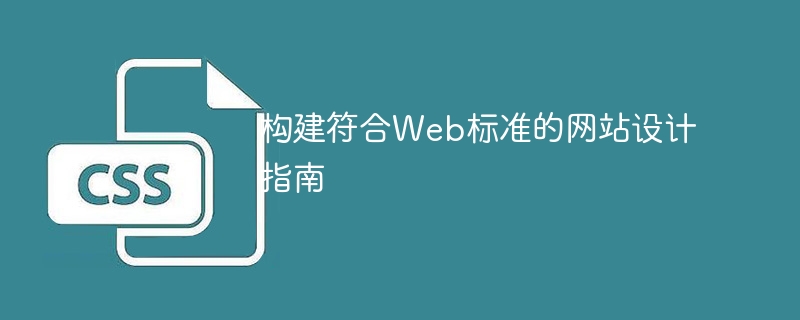

Building a website design guide that complies with Web standards
In the modern Internet era, websites have become an important platform for enterprises, organizations and even individuals to display their image, transmit information and communicate. . In order to ensure that the website runs normally on different devices and provide a good user experience, it has become an urgent need to build a website that complies with web standards. This article will introduce some key website design guidelines in 1,500 words, and attach specific code examples.
1. HTML specifications
HTML is the basic language for building web pages. Following HTML specifications can ensure the correct parsing and good accessibility of web pages.
<header></header> to represent the page header, <nav> represents navigation, <code><article></article> represents articles, etc.
<div> tag, but use semantic tags to better describe the page structure. <li>Use appropriate attribute values: Add appropriate attribute values to the label, such as <code>alt attribute for image description, title attribute for mouse hover prompts wait. Sample code:
<!DOCTYPE html>
<html>
<head>
<meta charset="UTF-8">
<title>网站标题</title>
</head>
<body>
<header>
<h1>网站标题</h1>
</header>
<nav>
<ul>
<li><a href="#">首页</a></li>
<li><a href="#">关于我们</a></li>
<li><a href="#">联系我们</a></li>
</ul>
</nav>
<article>
<h2>文章标题</h2>
<p>文章内容</p>
</article>
<footer>
<p>版权信息</p>
</footer>
</body>
</html>2. CSS specification
CSS is a language that controls the style and layout of web pages. Following CSS specifications can enhance the maintainability and Scalability.
<link> tag to avoid mixing styles in the HTML file. style attribute of the tag, but should be defined in an external style sheet. Sample code:
<!DOCTYPE html>
<html>
<head>
<meta charset="UTF-8">
<title>网站标题</title>
<link rel="stylesheet" href="styles.css">
</head>
<body>
<header>
<h1>网站标题</h1>
</header>
<nav>
<ul>
<li><a href="#">首页</a></li>
<li><a href="#">关于我们</a></li>
<li><a href="#">联系我们</a></li>
</ul>
</nav>
<article>
<h2>文章标题</h2>
<p>文章内容</p>
</article>
<footer>
<p>版权信息</p>
</footer>
</body>
</html>styles.css file:
body {
font-family: Arial, sans-serif;
margin: 0;
padding: 0;
}
header {
background-color: #333;
color: #fff;
padding: 20px;
}
nav {
background-color: #f2f2f2;
padding: 10px;
}
nav ul {
list-style-type: none;
margin: 0;
padding: 0;
}
nav ul li {
display: inline;
margin-right: 10px;
}
article {
padding: 20px;
}
footer {
background-color: #333;
color: #fff;
padding: 20px;
}3. Responsive design
With the popularity of mobile devices, responsiveness Style design has become an important design requirement, enabling the website to automatically adapt on different devices and provide a consistent user experience.
Sample code:
Add media queries to the styles.css file:
@media screen and (max-width: 768px) {
body {
font-size: 14px;
}
header {
padding: 10px;
}
nav ul li {
margin-right: 5px;
}
article {
padding: 10px;
}
footer {
padding: 10px;
}
}Through the above guide, we can build a website design that complies with web standards. These specifications and technologies can improve the accessibility, maintainability and user experience of the website, while also improving the website's ranking in search engines. I hope this article helps you build your website design.
The above is the detailed content of Create website design specifications that comply with web standards. For more information, please follow other related articles on the PHP Chinese website!
 How to recover browser history on computer
How to recover browser history on computer
 How to solve the problem that the folder does not have security options
How to solve the problem that the folder does not have security options
 file_get_contents
file_get_contents
 How to resume use of gas after payment
How to resume use of gas after payment
 Linux restart command type
Linux restart command type
 BigDecimal method to compare sizes
BigDecimal method to compare sizes
 Dynamic link library initialization routine failed
Dynamic link library initialization routine failed
 how to change ip address
how to change ip address




